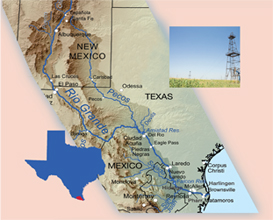The Rio Grande Valley is a booming area and the epicenter of the Texas produce industry, a critical economic engine for the region. With 1.3 million residents and population growth of 2.5 percent per year, the region boasts a healthy job market. Perhaps more importantly, it is also one of the country’s biggest gateways for fresh produce imports from Mexico.
Stars of the Show
Eagerly embracing the boom times are the four counties—Hidalgo, Cameron, Starr, and Willacy—that make up the Rio Grande Valley, or simply ‘the Valley’ as it is commonly known. Hidalgo County, with a population of about 816,000 living in 1,600 square miles, is the largest of the four. Hidalgo County’s biggest city is McAllen, with a population of 140,717, but the county is also home to Pharr, well known for the Pharr-Reynosa International Bridge, one of the most important ports of entry along the U.S. Mexico border.
At 1,276 square miles, Cameron County is smaller in area as well as population, which was estimated to be 417,276 in 2013. Brownsville, both the county seat and its largest city, is one of the fastest-growing areas in the United States, thanks in large part to international trade with Mexico. Indeed, when counted together with Matamoros, its sister city just across the border, greater Brownsville’s population jumps to more than 1.1 million.
Considerably smaller in terms of residents (61,963) but with virtually the same area (1,229 square miles) is Starr County; last in size is Willacy County, with just 784 square miles and 21,921 people.
Despite their different sizes, these four counties share a few important characteristics. Their demographic is overwhelmingly Hispanic; in Hidalgo County, for example, Hispanics account for 90 percent of the population. That’s no surprise, given the Valley’s proximity to Mexico and its long, comfortable history of commerce back and forth across the border.
Also key is their importance as both a region of produce growers and of produce importers. Nearly 40 percent of all fruits and vegetables consumed in the United States are imported from Mexico, and 50 percent of those imports come through Texas (the majority of the rest come through Nogales, AZ—for more information, see our spotlight article, “Nogales and the New Mariposa Port” in this edition).
Market Options
Much of the fresh fruit and vegetables that make their way to retailers and consumers across the nation begins with terminal markets and cold storage near border crossings. One such place is the McAllen Produce Terminal Market. Comprised of 42 acres, this hub of activity operates within 294,000-square-feet of warehouse space, and is outfitted with state-of-the-art technology and vast cold storage capabilities. Also known as the Central de Abastos, it is home to 90 businesses that import and export fresh produce from the United States and Mexico.



